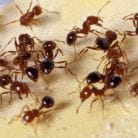Fire Ants are a hazard in any vegetable garden. They can do some damage to food crops, maybe the occasional nibble in a potato or pea pod. The biggest problem is the damage they can do to gardeners! The ant stings are painful and can be a serious medical issue.

Entomologists agree that fire ants came in to this county through Mobile, Alabama in the early 1900s. Today, the red imported fire ant (Solenopsis invicta), black imported fire ant (Solenopsis richteri), and their hybrids are what we have to deal with. See the UGA Publication Stinging and Biting Pests for more background information.
Fire ant stings are so painful because the ant’s mandibles allow the insect to grab on to the victim as the ant stings. The stinger can be used more than once and afterwards the insect is not impacted and goes on to live another day.
Ants do prey on some garden pests, like caterpillars. However, they also assist other damaging insects like aphids by keeping natural enemies away.
Controlling fire ants in the community garden can be a challenge. It takes an on-going approach and the use of several methods, real integrated pest management(IPM).

Fire ants like full sunshine, just like your vegetable plants. However, they don’t tend to stay in areas that are disturbed. Garden plots that are frequently worked or compost piles that are frequently turned aren’t the ants first choice of habitat.
Some publications recommend pouring boiling water over the mounds. A supply of boiling water would be hard to come by in a community gardening setting. Also, it could be a real danger to the gardener and the vegetable plants. Digging out the mounds is also sometimes recommended. This could create very angry ants that would be inclined to attack the digger.
Fall is a good time for chemical controls. Products containing carbaryl (Sevin), pyrethrins, and pyrethrins plus diatomaceous earth are approved for use in vegetable gardens and will kill fire ants. Be aware these products are not selective and will affect other insects as well. READ THE LABEL of any product you use and follow those directions.
Controlling Fire Ants in the Vegetable Garden, a Clemson University publication, discusses bait products approved for use in the home vegetable garden. Products containing spinosad or pyriproxyfen can be effective when used according to label instructions. Spinosad effects the ant’s nervous system and is considered fast acting. Pyriproxyfen prevents the development of worker ants. Products containing these ingredients include Conserve and Esteem. Be sure to place bait around the mound and not on top of the mound for the most effective use.
Using baits in the surrounding lawn or grass area can also be helpful. With any chemical product, read the label and make sure it is approved for the use you need. Do NOT use a product in the vegetable garden unless it is labeled for use in the vegetable garden. See the UGA Pest Management Handbook for more information on chemical control. UGA’s Dan Suiter is the leader of the Urban Pest Management Program and they do research on fire ant control.
The bottom line – fire ants are not easy to control. It takes diligence and a combination of approaches. Contact your local UGA Extension Agent for the latest information on dealing with fire ants.
Happy Gardening!
- ParSLAY the Day! - June 12, 2024
- 6th Annual Great Southeast Pollinator Census - May 28, 2024
- Are you ready for Pepper Palooza? - July 5, 2023
Excellent advice! Good to keep bite/sting relief pads close at hand in case the ants find you before you you see them!
Great advice! What about fall makes it a good time to control? Does it have to do with the planting cycle?
Good question, James. In the fall the fire ants are still actively feeding but they are staying closer to the soil surface. Perfect conditions for getting the best results out of your control methods.
That makes sense, thanks!